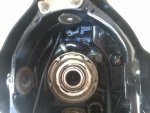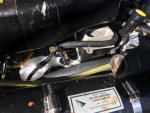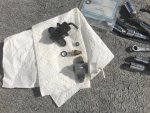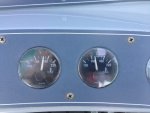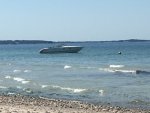- Joined
- Jul 18, 2011
- Messages
- 17,693
My plan for next weekend (Labor Day Weekend  ( in the USA) ) summer gone by already
( in the USA) ) summer gone by already 
I want to see if I can get a visual on the nose/fitting that comes through the transom assembly. My understanding is that there is a plastic insert that expands the intake hose to make a tight fit to the transom assembly ( similar to, but not identical to, the hose attachment at the bell housing). The fitting on the inside of the transom assembly seems to be a right angle, so getting my bores ope through there may not be possible.
The boat is in the water, so I am wondering about the ability to take off the right-angle fitting to get a good look at a possible Bravoitis situation. Water will be coming into the boat while I do this, so I will need to work fast, hope the bilge pump keeps up, and maybe stuff a rag into the opening if I get delayed.
Any thoughts about doing this?
If I am lucky, there will be a really low tide exit weekend and the boat will basically be resting on the bottom then, which would be a perfect situation to do this sort of thing.
I want to see if I can get a visual on the nose/fitting that comes through the transom assembly. My understanding is that there is a plastic insert that expands the intake hose to make a tight fit to the transom assembly ( similar to, but not identical to, the hose attachment at the bell housing). The fitting on the inside of the transom assembly seems to be a right angle, so getting my bores ope through there may not be possible.
The boat is in the water, so I am wondering about the ability to take off the right-angle fitting to get a good look at a possible Bravoitis situation. Water will be coming into the boat while I do this, so I will need to work fast, hope the bilge pump keeps up, and maybe stuff a rag into the opening if I get delayed.
Any thoughts about doing this?
If I am lucky, there will be a really low tide exit weekend and the boat will basically be resting on the bottom then, which would be a perfect situation to do this sort of thing.




















